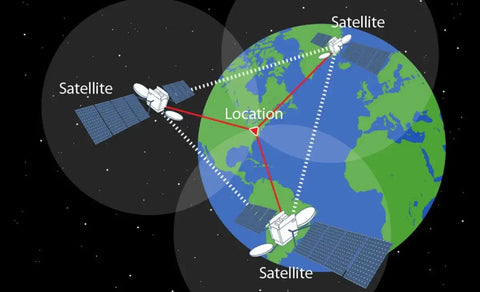GPS trackers work by receiving signals from satellites orbiting the Earth and using these signals to calculate the exact position on the ground.
In this article, we'll look at how a GPS tracker works including how it tracks a car and the difference between it and Bluetooth tracking.
Read More: How Do Airtags Work?

What is a GPS Tracker
GPS stands for Global Positioning System. It is a powerful global satellite navigation system consisting of approximately 24 satellites orbiting the Earth. These satellites form a Global Navigation Satellite System (GNSS), which continuously sends signals to Earth that are captured by devices equipped with GPS receivers and used to calculate position.
GPS technology is now used in a variety of civil applications such as communications security, vehicle navigation, and personal and pet location tracking.
- Global Positioning System (GPS): GPS is widely used in everyday life, especially for vehicle navigation and map services.
- Artificial Intelligence and Machine Learning: Used in business analytics, self-driving cars, and other areas. Examples include the Zeekr 007 self-driving feature and the Tesla Model 3 Autopilot feature.
- Business Use: Businesses that need to track vehicles and manage logistics can use GPS devices to monitor vehicle locations in real-time, optimize routes, and improve transportation efficiency.
- Family Use: Parents can use GPS devices to monitor the location of their children or elderly to ensure their safety.
How Does a GPS Tracker Work?
A GPS tracker is essentially a positioning device. It works by receiving signals from GPS satellites. GPS satellites orbit the earth every 12 hours and always send microwave carrier signals.
These waves travel at supersonic speeds and are picked up by the receiver of the GPS device. The process of using these signals to determine position is based on the principle of trilateration, which requires at least three GPS satellites to accurately calculate a 3D position.
It can be installed in a vehicle, integrated into a smartphone or carried by an individual. Inside the tracker, complex receivers process these signals to determine the exact location, speed, and even a 3D view of the route traveled by the object or person being tracked.
How GPS Tracker Works in The Car
The vehicle GPS tracker operates by receiving signals from satellites orbiting the Earth. The device calculates its position by determining the time it takes for the signals from the four satellites to reach the tracker. This information is then used to locate the vehicle on a map. Vehicle owners often use GPS trackers for safety, to monitor driving habits, or to track fleet vehicles.
GPS systems collect and analyze traffic flow data in real-time to provide information about road conditions. This can be very useful for drivers as the system can recommend the best route based on current traffic conditions and help avoid congested areas. For example, before a trip, an in-vehicle GPS may indicate that a route is heavily congested due to an accident or construction and then provide a faster alternative route.
How GPS Tracker Works in Mobile
In a cell phone, a GPS tracker functions in a similar way to that in a car. Mobile devices use satellite signals to determine their location. This feature is not only used for navigation, but also allows applications to provide services based on the user's location, such as weather updates, local news, or promotional offers from nearby businesses. Mobile GPS can also help locate a phone if it is lost or stolen.
Each application of GPS technology provides accurate, real-time location data to improve safety and efficiency in all aspects of life and business operations.
![]()
GPS Tracker vs Bluetooth Tracker
When discussing GPS trackers, many users also associate them with Bluetooth trackers. A comparison between the two is provided here to help better understand their differences and uses:
GPS Tracker
- Utilizing satellite technology, GPS trackers are capable of tracking a location globally and are suitable for locating any location.
- Due to the use of a global satellite network, GPS trackers are suitable for tracking items that move long distances, such as cars, bicycles, and pets.
- Traditional GPS trackers are larger and consume more power. Although new technology has made some devices smaller, the power requirement is still higher than that of Bluetooth devices.
- Due to the complexity of the technology, GPS trackers usually cost more than Bluetooth trackers.
Bluetooth Tracker
- Bluetooth trackers are small in size and have a long battery life, making them suitable for long-term use.
- Compared with GPS trackers, Bluetooth devices cost less and are easier to popularize.
- The effective coverage range of Bluetooth trackers is usually between 100 and 200 feet (30-60 meters), which is suitable for finding items lost nearby, such as keys or wallets.
- Dependent on other devices. Must be used with a smartphone or other Bluetooth-compatible device, which limits its ability to be used independently.
If you need to track items that may be far away from the initial location, or if you need to track them globally, a GPS tracker is a more suitable choice.
And if you just want to track small, often-lost items such as wallets or keys at home or in the office, a Bluetooth tracker is adequate and more economical. For example, Apple's AirTag and Seinxon wallet tracker utilize Bluetooth technology to help users locate keys, wallets, and other easily lost items.
Summarize
GPS trackers work by receiving signals from satellites in the sky. When your device captures signals from four or more satellites, it can calculate your exact location. This makes it easy to find your way around, monitor your vehicle, or ensure your safety no matter where you are.
Join Us and Get Exclusive Fan Benefits!

